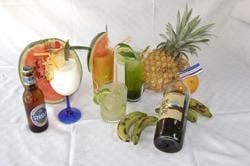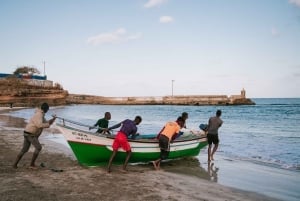Cape Verde Food & Drink
The result of a marriage between African and Portuguese cuisine, traditional Cape Verdean food features a wide array of interesting and savoury dishes. Naturally, fish and seafood play a key role in many of them, with fresh tuna being the most widely consumed fish locally, while lobster, squid, and a variety of shellfish are also in abundance.
The star and the most popular traditional dish is the Cachupa. It can be made from a mixture of corn, different meats, beans, sausages and vegetables.
The typical alcoholic drink in Cape Verde is Grogue, which is made from sugar cane. Cape Verdeans also drink a lot of tea, which is commonly served with couscous, corn paddies and tropical fruit jams.
Cachupa
Cachupa is a staple food in Cape Verde. It is said that one can measure the economic well-being of a family by seeing what they put in their cachupa. While in times of abundance or on special occasions, such as weddings, cachupa will be full of sausage and rich meats and vegetables; in the countryside, people tend to grow the basics of the dish, like mandioca, beans and a few vegetables, and make a much more modest cachupa. The rich cachupa with a lot of meats and sausage is called a Cachupa Rica.
Cooking cachupa can take a long time of boiling, which makes it expensive for Cape Verdeans, because of the scarcity and high prices of local fuels. In the countryside, the gathering of firewood for the cachupa is a common activity.
For Cape Verdean immigrants a meal of cachupa is a social occasion, used to remember and share stories about their homeland. It is also common to serve leftover cachupa in the morning, for example in cachupa ku ovo strelado, which consists of browned onions with cachupa and a fried egg, to make a breakfast of champions.
Considered a relative of cachupa, a local version of the Brazilian Feijoada (basis of black beans, tasty sausage and rice) is also common in Cape Verde.
The Mighty Grogue
Brought from the Caribbean and cultivated and harvested by slaves, sugar cane is used to make grogue. The word grogue comes from the nickname given to sailors to an Admiral in the Royal Navy, who had started watering down their rum. Soon enough, people started calling the drink itself grogue.
Much of the grogue produced in Cape Verde is quite artisanal; it is distilled using an old oil drum. The rhythm of the pressing of the cane for the making of grogue has repeatedly become an inspiration for music, and there are some popular mournful ballads that are associated with the activity, and commonly sung while making grogue.
The process of making the traditional drink has strong cultural roots. The sugarcane is harvested in the spring, the resulting cane bundles are then transported by women to the distillery, where it is then fed in to a press known as a trapiche. The resulting rum will later be watered down to become grogue.
Cape Verdeans use grogue to make pontche, a typical drink, which includes lime and sugar. Pontche is a close relative of the ponche from the Island of Madeira.
Sugarcane plantations and grogue production are mainly found in San Antonio, Sao Nicolau and Santiago. The drink is also used in traditional remedies, which are made by adding different herbs.
In tourist areas, the typical Brazilian cocktail Caipirinha is also made using grogue, instead of the original cachaca. Click on the link to learn how to make Caipirinha
Home Brew: Strela
Strela is the most popular beer in Cape Verde, which is produced by the Sociedade Cabo-verdiana de Cerveja e Refrigerantes. The blue label beer is exported to Gambia, with plans to be commercialized in other parts of the world where Cape Verdean immigrants live. Strela is sold in many formats, from 25cl bottles to 50 litre kegs.
Desserts
There are many popular desserts in Cape Verde. Most of them are made using some of the islands` tropical fruits, such as coconut, guava, mango and papaya. Among Cape Verde´s most enjoyable sweet delights are doce de papaya, cheese pudding, coffee pudding and doce de coco.
Recipes & Restaurants
For a true taste of Cape Verde, try this Cachupa Rica recipe with some homemade grogue.
To make a delicious grogue drink, boil 8 ounces of fresh water. Pour one ounce of clear rum into a mug, add ¼ cup of juice and a couple of tablespoons of sugar, mix in half the water till the sugar is blended in. Finally, pour the rest of the water and voila: You can now drink like a true pirate.
To experience Cape Verde´s local cuisane, you can try Luciano’s Café Cultural in Santa Maria (Sal) for some great local dishes and some homemade Grogue.
Cape Verde has many delicious flavours, and they are ready to be experienced across the archipelago, the diaspora and beyond. So, bon appétit!












